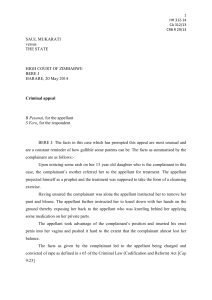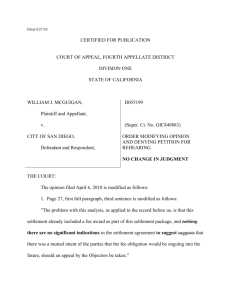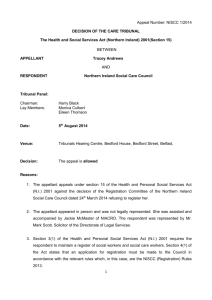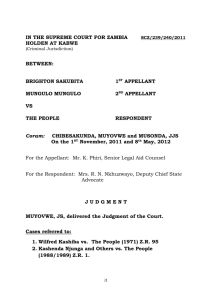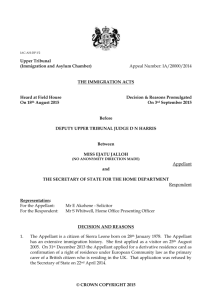58-14
advertisement
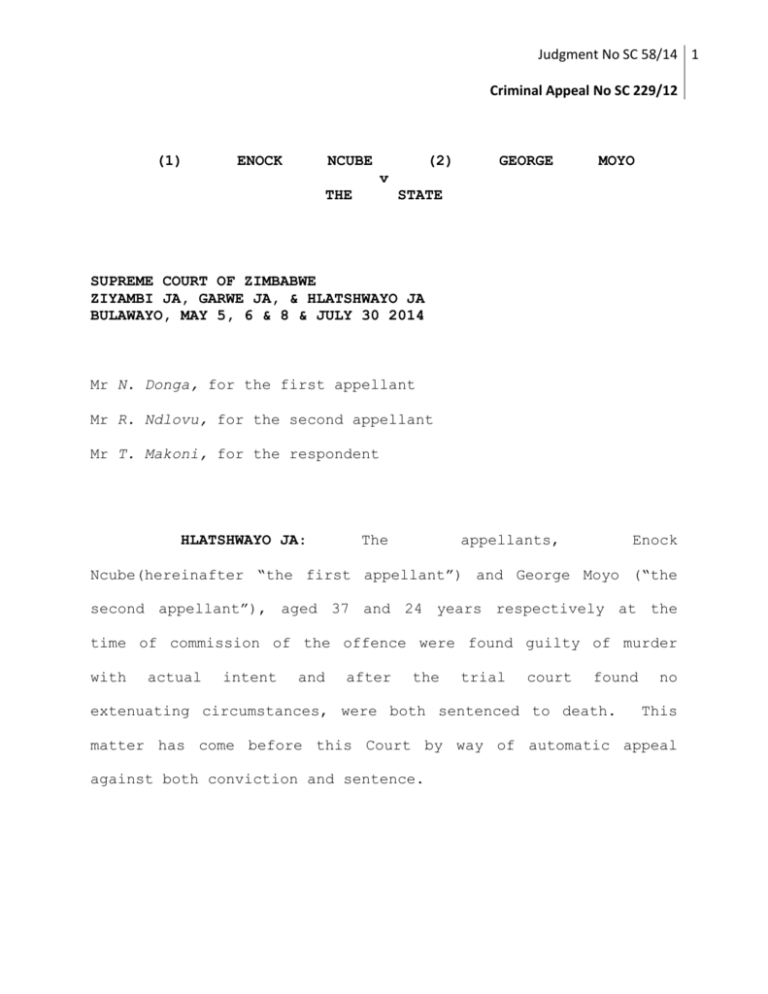
Judgment No SC 58/14 1 Criminal Appeal No SC 229/12 (1) ENOCK NCUBE (2) GEORGE MOYO v THE STATE SUPREME COURT OF ZIMBABWE ZIYAMBI JA, GARWE JA, & HLATSHWAYO JA BULAWAYO, MAY 5, 6 & 8 & JULY 30 2014 Mr N. Donga, for the first appellant Mr R. Ndlovu, for the second appellant Mr T. Makoni, for the respondent HLATSHWAYO JA: The appellants, Enock Ncube(hereinafter “the first appellant”) and George Moyo (“the second appellant”), aged 37 and 24 years respectively at the time of commission of the offence were found guilty of murder with actual intent and after the trial court found extenuating circumstances, were both sentenced to death. no This matter has come before this Court by way of automatic appeal against both conviction and sentence. Judgment No SC 58/14 2 Criminal Appeal No SC 229/12 The 23 June allegations 2006 at about against 22:00 the appellants hours, they, are acting that in on common purpose, proceeded to Phakama Secondary School, Plumtree, with the intention to commit the intention to steal and theft. offence of housebreaking with They armed themselves with knives and also carried tools for breaking in viz, screwdriver, crow bar, lamp and a box of matches. On arrival at the school they broke into the administration block and while inside, lit a lamp and loaded stolen items into a bag. The stolen items included a solar panel, solar chargers, stapler and pens. The appellants were spotted by the deceased, a teacher, who was arriving at the school at that time. The deceased rushed to the school quarters where he alerted Bakani Nduna Ndlovu who is also a teacher. The deceased armed himself with an axe and went to investigate followed by Bakani Ndlovu. On surrender arrival and come the deceased out. The ordered first the appellants appellant, instead to of surrendering, immediately bolted out of the administration block while carrying the stolen property loaded in a bag. The Judgment No SC 58/14 3 Criminal Appeal No SC 229/12 deceased gave chase and managed to catch up with the first appellant and in the process, the first appellant dropped the bag containing the loot and continued to flee. The deceased followed in hot pursuit and after about 100 metres, he caught up with the first appellant again but the appellant wiggled out of the deceased’s grip by removing his own black leather jacket leaving the deceased holding it. give up the chase and after However, the deceased did not about another 150 metres he “cornered” the now tired first appellant and ordered him to lie down. The first appellant, according to his own testimony, pretended to comply with the order, but suddenly drew out his okapi knife from his back pocket, opened it and stabbed the deceased once on the lower abdomen and deceased fell down and died on the spot. The first appellant went back to retrieve the stolen loot but, hearing foot-steps of other people, gave up and escaped. In the meantime, the second appellant had seized the opportunity presented by the bolting out of the first appellant and sneaked away from the scene in a different direction evading or outpacing Bakani Ndlovu in the process. Judgment No SC 58/14 4 Criminal Appeal No SC 229/12 A post mortem examination of the deceased concluded that the cause of death was (a) haemorrhage shock (b) intraabdominal bleeding (c) stab wounds, and (d) assault. The stab- wounds are listed in the report under “marks of violence” as (a) stab wound right arm (5 x 2cm) and (b) left abdomen (3 x 2 x 10cm). Three main contentions were advanced on behalf of the appellants, namely that: (a) (b) (c) The state did not disprove the defence of person (self-defence) advanced by the first appellant The state did not establish the basis of common purpose to warrant the conviction of the second appellant for the murder of the deceased by the first appellant. Extenuating circumstances existed in the matter warranting the non-imposition of the death penalty. We shall examine each one of them in turn below. SELF DEFENCE One of the cardinal requirements for the success of the defence of person or, in this case self-defence, is that the resisted attack must be unlawful. See s 253 of the Criminal Law (Codification and Reform) Act, [Cap 9:23] (hereinafter called the “Criminal Code”). The confronting of burglars and ordering Judgment No SC 58/14 5 Criminal Appeal No SC 229/12 them to surrender on pain of death is not an unlawful attack. Similarly, the subsequent concerted chasing after the first appellant in order to effect a citizen’s arrest is perfectly lawful. Mr Donga, for the first appellant submitted that the fact that the deceased chased the first accused while armed with an axe for about 250 metres and could have struck him with it even after he had dropped the loot, entitled the first appellant to exercise his right of self-defence. This however, must be weighed against proven facts. contention, In doing so, care must be taken to balance the first appellant’s version of events given surrounding that he is the case against facts the sole witness of and what beneficiary of any exaggeration on his part. probabilities transpired and The court a quo, therefore, did not misdirect itself in treating his evidence with caution, having found him to be an untruthful witness. The fact that the deceased was armed with an axe is not contested. One can go so far as to say that it was perfectly prudent and lawful on the deceased’s part to be so armed in confronting burglars at night who may well be armed with lethal weapons and in fact turned out to be carrying Judgment No SC 58/14 6 Criminal Appeal No SC 229/12 knives. However, the evidence does not show a reckless use of the axe by the deceased. First he calls out for the burglars to surrender and come out but the first appellant ignores this and bolts out of the room with the loot. He gives chase and hits the fleeing burglar with a stone or some other non-lethal weapon he happened upon but avoiding using the axe. When the first appellant continues to flee, he grabs him by the leather jacket which the burglar wriggles out of and escapes. When he finally has to use the axe, the deceased opts to use the non-lethal end of the axe, testimony. even according Yet still, to the in the final first appellant’s own confrontation, when the first appellant is “cornered”, the deceased does not hack him down with the axe which he could easily have done. Rather he again orders him to surrender, to lie down, which he pretends to do but suddenly draws out a knife and stabs the pursuer. Therefore, the court a quo did not misdirect itself in disbelieving the first appellant since his version of events either did not tally with the facts or was exaggerated for his own benefit. For example, while the first appellant maintained that he stabbed the deceased only once, the post-mortem report Judgment No SC 58/14 7 Criminal Appeal No SC 229/12 established that the deceased was stabbed twice on the right arm and the left abdomen. Penultimately, while the first appellant testified that he was unaware that he had killed his pursuer, he still had the gall to turn back to try and retrieve the loot and only retreated when he heard footsteps of other people. Finally, the injuries he claims to have sustained from the attack by the pursuer were found by the court a quo more likely to have been sustained in some fall in his bid to escape. It is clear, therefore, from the above discussion, that the lawful exercise of the right of defence of property including the right to use moderate force to effect a citizen’s arrest were not exceeded by the deceased so as to constitute an unlawful attack entitling the first appellant to self-defence. Thus, the court a quo, in my view, correctly rejected this defence. COMMON PURPOSE The position in our law pertaining to the doctrine of common purpose was summarized by GARWE J (as he then was) in the case of The State v Charles Sumani and Stephen Akudele HH-752000 thus: Judgment No SC 58/14 8 Criminal Appeal No SC 229/12 “The position is now settled that where accomplices break into premises with a weapon known to all and the weapon is used in the murder of a victim all would have at least a constructive intent to kill – see Nyathi v Two Ors SC 52/95. In Chareka & Anor SC 40/93 two accused acting in concert had a firearm in their possession. The second accused was found guilty of murder with constructive intent. In Ngulube & Anor v S SC 112/93 the Supreme Court held that the first appellant should have been found guilty of murder with constructive intent on the basis that being aware that his accomplice was armed with a lethal weapon he must have appreciated and foreseen the possibility of his colleague resorting to the use of the weapon to kill in furtherance of their common objective to effect the robbery. In this case it is clear accused 1 must have, at the very least, been aware that accused 2 would resort to the use of the axe in order to successfully effect the robbery” pages 11 – 12 of cyclostyled judgment.” Mr Ndlovu, for the second appellant sought to argue that the second appellant’s mens rea in casu was restricted to the planned house-breaking with intent to steal and theft. He submitted that when they were surprised by the deceased wielding an axe and standing at the door of the school building and demanding that they should come out, the second appellant never produced a knife or any weapon to attack or frighten the deceased. Instead, his decision was to escape under cover of darkness. When the first appellant had bolted out of the building with the bag laden with stolen items and the deceased Judgment No SC 58/14 9 Criminal Appeal No SC 229/12 chased after him, so the submission went, the appellant did not join in the chase to attack the deceased or rescue the first appellant. The second appellant simply walked out of the building and out of the school and proceeded to his homestead. However, the above submission misses the point, which is the age-old question whether the second appellant, by sodoing, sufficiently disassociated common purpose. it Was legally himself effective from the withdrawal original for him merely to run away? Or did he have to do more for the chain connecting him to the subsequent actions of the first appellant to be broken; for instance by surrendering himself as demanded by the deceased or otherwise try to avert the danger that he had created by association? In S v Ndebu & Anor 1985 (2) ZLR 45 (SC) McNALLY JA quoted English and American case law to the effect that a lastminute withdrawal on its own was insufficient to exculpate a secondary party from the main charge. Such a party must do more for the defence “countermand” or of “withdrawal” “repent” the to succeed. original He or she instruction must or Judgment No SC 58/14 10 Criminal Appeal No SC 229/12 understanding. The withdrawing party must literally “step on the lit fuse” in order to successfully dissociate from a conspiracy to blow up a building with dynamite. This vexed question pertaining to the sufficiency of a “withdrawal” from a common purpose was dramatized in William Shakespeare’s play, King Richard III, where two murderers are sent by the king to murder his brother, Clarence. The second murderer seems to have a change of heart at the last minute, vainly tries to prevent the killing by warning Clarence to look behind him as the first murderer moved in to stab him. The remorseful second murderer further distances himself from the crime by refusing his share of the reward, but in the eyes of the playwright they both remain murderers. In S v Ndebu & Anor (supra) the convicted of murder and sentenced to death. appellants were During the course of housebreaking at a dwelling known to be occupied at the time, the appellants were surprised by the householder. The second appellant not in possession of a firearm, immediately fled and had already run some distance away before he heard the sound of Judgment No SC 58/14 11 Criminal Appeal No SC 229/12 gunshot fired by second appellant which killed the deceased. It was observed as follows regarding the liability of the unarmed second appellant. “I will content myself in this case by saying that on the facts I am not at all satisfied that the second appellant dissociated himself from the murder. He had gone along with a common intention to commit housebreaking and theft, and if necessary armed robbery. He had taken part actively in the break-in, and had himself then cut the telephone wires. He knew and appreciated the risk that if someone in the house woke up the firearm might have to be used to subdue the residents or to effect an escape. He was there participating when precisely that situation arose. As it happened he was so placed that he could run away. But by that stage what he did was no longer material. The reason for that is clear. The risk which he deliberately took was not related to what he himself might do but what his armed companion might do if challenged or cut off. He had linked his fate and his guilt with that of his armed companion. The mind that needed changing was not his but his companion’s. His constructive intention to kill depended on a decision by his companion”. P 50 (E-H) After examining case law in South Africa and Zimbabwe on this subject, the following conclusion is drawn by the learned author, Jonathan Burchell in Principles of Criminal Law 4 ed p 491: “The ultimate decision whether a person’s dissociation from a common purpose can serve to exculpate him or her for crimes committed by the group after dissociation is a value judgment, but a number of factors relevant to the inquiry have emerged from the case law. These factors need to be weighed in the balance by the court in reaching an Judgment No SC 58/14 12 Criminal Appeal No SC 229/12 equitable decision on whether dissociation is effective or not.”(emphasis in the original text) legally COMRIE AJA in Musingadi, 2005 (1) SACR 395 summarized some of the factors relevant to a dissociation inquiry as follows: “[M]uch will depend on the circumstances: On the manner and degree of the accused’s participation; on how far the commission of the crime has proceeded; on the manner and timing of the disengagement; and, in some instances, on what steps the accused took or could have taken to prevent the commission or completion of the crime... The greater the accused’s participation, and the further the commission of the crime has progressed, then much more would be required of an accused to constitute an effective dissociation. He may even be required to take steps to prevent the commission of the crime or its completion. It is in this sense a matter of degree and in a borderline case calls for a sensible and just value judgment.” GUBBAY CJ in Beahan 1992(1)SACR 307(S) p 324 opined that where ‘a person has merely conspired with others to commit a crime, but has not commenced an overt act toward the successful completion of that crime, a withdrawal is effective upon timely and unequivocal notification to the co-conspirators of the decision to abandon the common unlawful purpose’. Judgment No SC 58/14 13 Criminal Appeal No SC 229/12 The Criminal Code now states the position of the withdrawing accomplice in s 200 as follows: “200 Withdrawal from crime by accomplice An accomplice shall not be guilty of a crime committed by an actual perpetrator if, before the crime has been committed, the accomplice voluntarily desists from further incitement of, conspiracy with, or authorization or assistance to the actual perpetrator and eithera) renders wholly ineffective his or her previous incitement, conspiracy, authorization or assistance; or, b) gives warning of the crime to a police officer or other person with authority to prevent the commission of the crime, in sufficient time to enable the police officer or other person to prevent its commission.” In participation subordinate, appellants the present of the but were that armed case second of with the manner appellant a was co-principal knives for the and not degree that offender. clear of of a Both purpose of warding off any challenge to their enterprise of unlawful entry and theft. This is highlighted in the second appellant’s confirmed warned and cautioned statement where he states: “What I know is that I left home with Enock Ncube carrying knives. Enock had his and I had my own and further we had tools” Judgment No SC 58/14 14 Criminal Appeal No SC 229/12 The knives in their possession were not essential for the purpose of unlawfully breaking into the school administration block as they only needed a screw-driver and a crowbar which they used for that purpose. Therefore, the court a quo did not err in accepting that if the knives were surplus to what the appellants required to complete their housebreaking endeavor then their possession was for the sole purpose quashing any resistance should such opposition arise. of And it did arise in the form of the deceased demanding their surrender and submission and doggedly pursuing the first appellant. The occurs when fortuitous. deceased’s purported the The crime bolting chasing after withdrawal is all away him by gives perfect opportunity to slip away. offence had progressed, but more by the second completed his the and appellant is co-offender second purely and appellant the the Given the degree to which the was expected of the second appellant if he desired to dissociate from the common purpose. He could have surrendered himself and/or called upon his cooffender to do the same or assisted in the retrieval and handing over of the stolen property. He could have warned the deceased Judgment No SC 58/14 15 Criminal Appeal No SC 229/12 that the first appellant was armed, that he should not pursue him that he himself was surrendering identify the fleeing party. he disarmed challenger or in way would be able to In short, as was said in Ndebu, had dissuaded some and his he companion might or perhaps protected have purged the his constructive intention. Once accomplice foreseeable more, who the fails Criminal to additional Code effectively crimes in s 199 withdraw committed by makes guilty the an of actual perpetrator. Accordingly, the trial court correctly found that the first appellant However, as the was line guilty of of murder authorities with quoted actual above intent. show, the second appellant who was not at the actual scene of the murder can be found guilty only of murder with constructive intent. Mr Makoni, for the respondent correctly conceded as much in his heads of argument. Judgment No SC 58/14 16 Criminal Appeal No SC 229/12 EXTENUATION The court a quo made a finding that there was no extenuation in relation to both appellants having convicted both of murder with actual intent. It reasoned as follows: “I find that the accused were sober. They planned to commit this offence, armed themselves with knives, screw driver in order for them to use in the housebreaking. Resistance came their way and one of the knives was used.” The finding, court having below did dismissed not the misdirect first itself appellant’s in so version pertaining to the chase and the injuries he supposedly suffered. However, the correct verdict for the second appellant as posited above is murder with constructive intent. Nonetheless, case law shows that an accomplice who fails to dissociate himself from a common purpose although convicted of murder with constructive intent may still be liable to be sentenced to death. It was found extenuation sentenced him to submitted that the court with up respect to 20 to years the a quo second imprisonment should have appellant based on and a comparison with the case of S v Ndebu (supra) where the death Judgment No SC 58/14 17 Criminal Appeal No SC 229/12 sentence was substituted with a sentence of fifteen (15) years imprisonment for the unarmed accomplice. However, the Ndebu case is distinguishable from the present one. In Ndebu, extenuation was found in that the withdrawing accomplice played a subsidiary role and abandoned the common purpose timeously. In the present case, the second appellant did not play a subordinate role as he was in fact a co-principal offender and his belated dissociation was fortuitous and not unequivocal, taking advantage, as he did, of the pursuit of his accomplice by the deceased to make good his own escape. DISPOSITION The appeal against conviction and sentence in relation to the first appellant is dismissed. The appeal against conviction by the second appellant succeeds to the extent of the court a quo’s verdict of guilty of murder with actual intent being set aside and substituted with his being found guilty of murder with constructive intent. However, the second appellant’s appeal against dismissed. sentence is without merit and is hereby Judgment No SC 58/14 18 Criminal Appeal No SC 229/12 ZIYAMBI JA: I agree GARWE JA: I agree Lazarus & Sarif, 1st appellant’s legal practitioners R.Ndlovu & Company, 2nd appellant’s legal practitioners The Prosecutor-General’s practitioners Office, respondent’s legal

